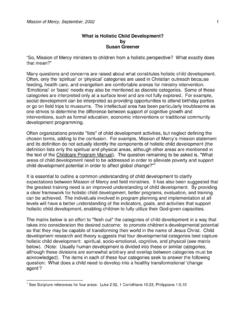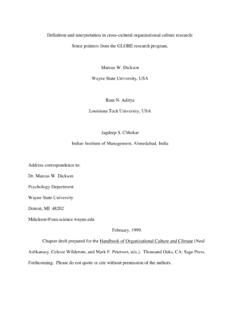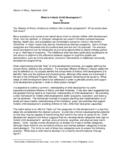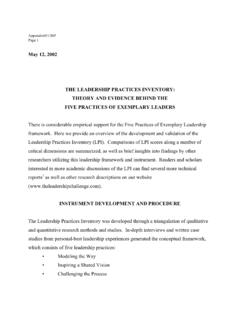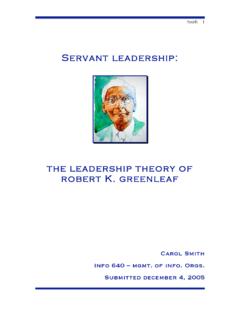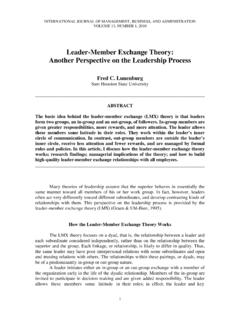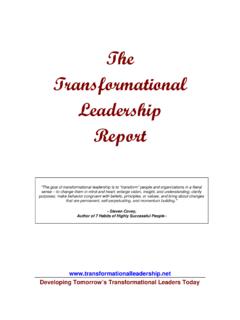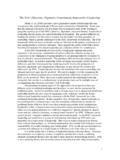Transcription of Substitutes-for-leadership theory: Development and basic ...
1 Substitutes-for-leadership theory : Development and basic concepts. Subject(s): leadership Source: leadership Quarterly, 1997 [sic], Vol. 8 Issue 2, p103, 6p Author(s): Schriesheim, Chester A. Abstract: Focuses on Substitutes-for-leadership theory , and what it consist of. Background information on research done in the area of leadership ; Conclusion that additional work on substitutes is needed; Benefits of incorporating a level-of-analysis perspective into substitutes theory and research. AN: 9708271254 ISSN: 1048-9843 Note: This title is not held locally Database: Academic Search Elite Substitutes-for-leadership theory : Development AND basic CONCEPTS In the mid-1970s, the field of leadership research was dominated by two theories: Fiedler's (1967) Contingency Model, and House's (1971) version of Path-Goal theory . However, during these years efforts were also undertaken on a number of different fronts, including attempts to make sense of the large body of literature that had accumulated over a 20+ year period using the Ohio State leadership measures of "Consideration" and "Initiating Structure" (for an overview of early Ohio State work, see Fleishman, 1973; for a review of the full body of Ohio State literature, see Kerr, Schriesheim, Murphy, & Stogdill, 1974).
2 At Ohio State, where I began as a doctoral student in 1971, a group of established and fledgling leadership scholars were in hot pursuit of leadership knowledge on a number of fronts ( , Jermier & Schriesheim, 1978; Kerr et al., 1974; Kerr & Schriesheim, 1974; Schriesheim & Kerr, 1974, 1977a, 1977b; Schriesheim & Schriesheim, 1974, 1978; Schriesheim & Stogdill, 1975; Schriesheim & Von Glinow, 1977). Ralph Stogdill was the most senior scholar in this group, and Steve Kerr, although relatively new, was also senior to the rest of the group. Other group members included doctoral students Jean Bish, Janet Fulk Schriesheim, Tom Mawhinney, Jim Tolliver and, later, John Jermier and Mary Ann Von Glinow. New assistant professor Chuck Murphy was also involved in several of the early projects as well ( , Kerr et al., 1974; Schriesheim & Murphy, 1976). Steve proved to be the dynamo who drove much of the group's work, Ralph being extremely involved with finishing the Handbook of leadership (Stogdill, 1974) and leadership : Abstracts and Bibliography 1904 to 1974 (Stogdill, 1977).
3 However, Ralph often provided wise advice, and Bob House, Steve Kerr's mentor from Baruch College at , was frequently involved from afar ( , Schriesheim, House, & Kerr, 1976). In fact, as one might expect, Bob's influence on our little group proved to be quite substantial, as Steve's earliest writings were with him ( , Kerr, House, & Wigdor, 1971). Additionally, Steve had developed an interest in further pursuing earlier research ( , House & Wigdor, 1969; Wigdor, 1969) on the effect that "organizational independence" had on relationships between perceived leader behaviors and various outcome criteria. The result of these efforts was some articles on organizational independence (Kerr, 1973; House & Kerr, 1973), as well as the coining of the phrase " substitutes for leadership " (Kerr, 1973, p. 127). This concept was initially presented as involving "..certain situational determinants" that have the potential for "..rendering the leader incapable of influencing subordinate satisfaction very much for either better or worse" (Kerr, 1973, p.)
4 127). Several subsequent publications expanded on this basic idea, albeit in a nonsystematic and mostly illustrative manner. For example, Kerr et al. (1974, p. 75) stated that: There are many instances where " substitutes for leadership " exist, which act to reduce subordinate dependency upon the leader, and consequently impair the leader's ability to influence criteria relationships very much for either better or worse. Thus, the existence of extensive government contracts, or rigid bureaucratic rules and regulations, can reduce subordinates' structuring-information needs almost to zero. In other instances the task may be totally specified by technology, or "professional standards" and methodology may render the leader superfluous (Kerr, 1974).[1] In such cases attempts by the leader to impose Structure would tend to be viewed by subordinates as redundant, or "merely as unnecessary to clarify the requirements that subordinates were expected to meet" (House, Filley, & Kerr, 1971).
5 A similar but more developed early statement of the substitutes idea may be found in Kerr (1974, pp. 124-125) (see footnote 1), while the first systematic discussion of what is now referred to as " Substitutes-for-leadership theory " is in Kerr (1976)--which began elaborating the concept and first presented the distinction between substitutes and neutralizers (see, also, Kerr, 1977). My involvement with substitutes theory was and has never been great, partly because I did not and have not been able to see how its basic theoretical tenets ( , Kerr & Jermier, 1978) are anything more than elaborations of fundamental ideas contained in House's (1971; House & Dessler, 1974) Path-Goal leadership theory and Hunt's (1975) and Osborn and Hunt's (1975) concept of nonleader sources of clarity. Additionally, I've also not been able to see how the recent statistical restatement of substitutes theory (Howell, Doffman, & Kerr, 1986) adds to well-known statistical fundamentals, such as those dealing with suppressor effects in multiple regression (cf.)
6 Cohen & Cohen, 1983). However, in a section of a paper written jointly with me, Steve provided a statement of why he felt substitutes theory was a worthwhile new contribution to the leadership literature: The Path-Goal theory does recognize that under some circumstances both goals and paths to goals may be clear, and attempts by the leader to provide clarification will be redundant and unnecessary. Even in such instances, however, the theory predicts specific consequences for subordinate satisfaction, morale, motivation, and acceptance of the leader .. While certain leader behaviors are therefore recognized by the theory to be redundant and unnecessary in particular situations, in no situation are they explicitly hypothesized to be irrelevant. However, data from numerous studies collectively demonstrate that in many instances leader behaviors (as operationalized) are irrelevant. A potentially useful area for research, then, concerns the identification of those individual, task, and organizational characteristics which may act as " substitutes for leadership " in their ability to negate the leader's ability to influence subordinate performance, satisfaction, etc.
7 , regardless of the leadership style employed (Schriesheim & Kerr, 1977b, p. 44). I have never found this argument compelling, but others, such as Jim Meindl, apparently do.[2] In any event, by virtue of its being treated in this special section of leadership Quarterly, as well as by its having spawned a goodly-sized literature of its own (for reviews see Bass, 1990; Podsakoff, MacKenzie, & Fetter, 1993a), substitutes theory must be recognized as one of the major approaches to leadership research today. substitutes theory What, then, is " Substitutes-for-leadership theory "? substitutes theory was first fully developed by Kerr and Jermier (1978), elaborating on earlier initial statements by Kerr (1976, 1977). Howell et al. (1986) subsequently extended the taxonomy underlying the theory and developed a set of statistical criteria for determining whether neutralizers, enhancers, supplements, and/or substitutes for leadership are operative in a particular situation.
8 Finally, Podsakoff et al. (1993a, pp. 26-29) provided a definitional and statistical clarification of the Howell et al. (1986) effects. According to Howell et al. (1986), neutralizers are variables which make it impossible for leaders to influence outcome criteria. Neutralizers do not directly correlate with criteria but serve to reduce, block, or cancel leadership -outcome relationships. Enhancers, in contrast, are variables which also are not directly associated with outcomes but which augment or serve to strengthen leadership -criteria relationships. On the other hand, supplements have their own relationships with criteria and do not neutralize or enhance leadership effects. Finally, substitutes for leadership are variables that make leadership impossible and unnecessary. substitutes are directly related to subordinate outcome criteria and they block or cancel leadership -outcome relationships; they are therefore like neutralizers but have criterion relationships of their own.
9 In simplified form, Bass (1990) summarizes the theory in multiple regression terms as follows..if y = ax + bz, when x is leadership behavior, z is the moderator, and y is predicted subordinate performance, then: z is a neutralizer if b is negative and z, although correlated with x, does not correlate with y; z is an enhancer if b is positive and z does not correlate with y; z is a supplement if it correlates with y adding to the correlation of x with y; and z is a substitute if it correlates with .9 while x adjusted for z does not (Bass, 1990, p. 682). All four of the above different types of effects may be tested via multiple regression using the more detailed analytic procedures outlined by Howell et al. (1986) and Podsakoff et al. (1993a, pp. 26-29). Additionally, refined measures of hypothesized substitutes variables are now available for use in such research ( , Podsakoff et al., 1993a; Podsakoff, Niehoff, MacKenzie, & Williams, 1993b). However, whether future theory and research will prove fruitful for the advancement of knowledge about leadership phenomena is unclear.
10 Podsakoff et al. (1993a) were somewhat pessimistic in summarizing research on substitutes theory : ..since there is not even one substitute variable that consistently moderates the effects of a leader behavior on a criterion variable across studies, questions must be raised about the adequacy of the substitutes model, even assuming that the model applies only to certain substitute-leader behavior interactions (p. 40). However, Podsakoff et al. (1993a) also concluded that, "..we are not suggesting that the study of leadership substitutes should be abandoned, or that substitute variables are unimportant" but that "..the theoretical basis for the Substitutes-for-leadership model needs additional refinement" (p. 40). CONCLUSION It thus seems clear that additional work on substitutes theory is needed. Additionally, future efforts might very well benefit from incorporating a level-of-analysis perspective into substitutes theory and research ( , Podsakoff & MacKenzie, 1995), along with better construct definition and measurement ( , Podsakoff et al.)
